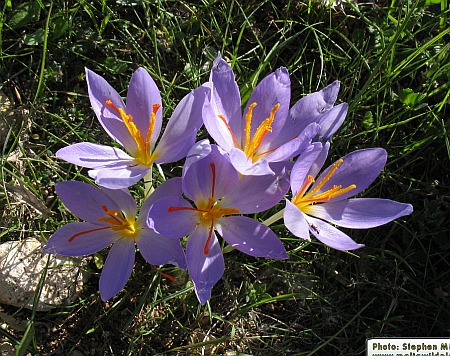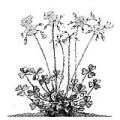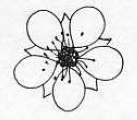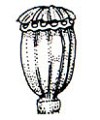| Nomenclature | |
| Species name: | Crocus longiflorus |
| Closely Related Species: | Crocus medius; Crocus nudiflorus; Crocus biflorus |
| Common name: | Crocus Longiflorus (no English name) |
| Maltese name: | Zaghfran Salvagg |
| Plant Family: | Iridaceae |
| Name Derivation: | Crocus = saffron (latin); longiflorus = long flowered, referring to the long neck of the flower (latin). |
| Botanical Data | |||||||||||||||||||||||||||||||||||||||||||||||||||||||||||||||
| |||||||||||||||||||||||||||||||||||||||||||||||||||||||||||||||
| |||||||||||||||||||||||||||||||||||||||||||||||||||||||||||||||
| |||||||||||||||||||||||||||||||||||||||||||||||||||||||||||||||
| |||||||||||||||||||||||||||||||||||||||||||||||||||||||||||||||
| |||||||||||||||||||||||||||||||||||||||||||||||||||||||||||||||
| Plant Description | ||
| Life Cycle: | Perennial | |
| Habitat: | Stony or rocky places in grassland, usually over limestone at up to 1900m. Plant prefers direct sunlight. | |
| Sources in Malta: | Dingli | |
| Plant Height: | 15cm | |
| Flowering Time: | Oct - mid Dec | |
| Poison: | No | |
|
This low (10cm approx) perennial grows from underground brown and fibrous corms. Around the start of Autumn, the vegetative corm start developing the reproductive flower. The flower grows directly from the corm with no real stalks or stems. The leaves also grow slowly directly from the corm and strangely they develop fully just at or after blossoming of the flowers.
The leaves, are variably long - about 5-10cm, thin (2 to 3mm), entire outline and have a characteristic central white stripe running longitudinally along the leaf axis. The shape of these leaves are sometimes described as ensiform, hence sword-blade shape. If the leaf is simple, the flower is not! It is highly coloured, sweet scented, and attractive. It is made up of 6 petals of a pale violet / lilac colour, but no sepals. At the outer side there is a pattern of pinnate dark-violet/purple veins which are less prominent at the inside part of the petal. The petals are mostly un-fused, but they constrict and then join at the 'base' of the flower to form a thin tube which goes further down under the soil to the corn. At about half way. the tube is protected by a whitish / pale green sheath which covers the and support the flower neck. At the zone where the petals constrict to form a tube, hence at a region referred to as the throat, there is a yellow coloration, more prominent from inside of the flower, but still noticable from the exterior. At the throat region, 3 stamens are joined 3 petals alternately. The stamens are erect and rod-shaped and are bright yellow in colour. The female part is more contrasting, having a bright orange-red colour, prominent, and at a point the main style divides to three branches which have short lobed ends, where the stigma are present. The style goes down the flower neck until it reaches the ovary located under the soil. The ovaries develop to a seed capsule (the fruit) which may emerge to the surface and open up when the seeds are ripe. The fruit is very difficult to locate or find. Apart that they may be partly or just submerged in the soil, they are brown like the soil and quite small. Other wild plants would also cover most of the soil surface in Winter. | ||
| Additional Information |
|
Sub-endemic species This plant is found in few places around the central Mediterranean region and so it is nearly an endemic species to Malta, or what is referred to as sub-endemic. Apart from Malta it is only found in Egadi islands (West of Sicily), some parts of Sicily and South Italy mostly in Calabria, Murge, Basilic. a Serraneta, Pollino, Sila, Rosarno, Mongiana, Serra S, R nel Salern. (Monte di Stella, Monte Sacro), Bruno and also in Dalmazia. Reports that it was seen in Tunisia, were false. [WWW-42] MarZ Observations Species in danger of disappearing from the Maltese islands It has been reported by many botanists, namely E. Lanfranco [300] that this plant is continually decreasing in number from our islands, mainly due to land management and bad disposing of rubble in the environment. It is very difficult to resist the temptation of not picking up this wonderful, colourful and scented flower, but bear in mind that this species is in danger of disappearing from our country and must NOT BE PICKED UP at all costs. Apart from the fact that the plant is attractive and scented, another factor which acts against the plant is that it grows low and one is more encouraged to cut it up to look and smell it better. Additionally each individual plant may develop only 2 - 3 flowers in its life cycle and so it is more important to leave the flowers to perform their reproductive process. Unfortunately, seed production and dispersion in the wild is not much effective for this plant either. Grown ups should educate their children too to start caring about our fragile environment. They can pick up for example lellux and haxixa ingliza instead, even if ideally they should not either! Again, please DO NOT PICK UP this wild, sub-endemic, en-dangered, flowering plant. [SM] |
| Picture Gallery | |||
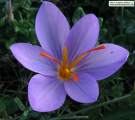 |
 |
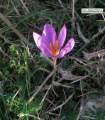 |
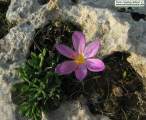 |
| Photo of the colourful flower in situ | Photo of flower at an angle to show better its bright yellow stamens, orange-red stigma and yellow throat (constriction base of flower) | Photo of flower taken from www.thealpinehouse.fsnet.co.uk | Top view photo of flower taken from www.wikipedia.org |
| Flower pH Indicator Properties | |
| No flowers where collected for this study so as to protect this rare plant | |
| pH Turning points: | 1__ |
| Interpretation of Result: | 2__ |
| Conclusion: | 3__ |
| Further Information and Links | |
| > The Pleasure of Crocuses by Charlie Challenger | > Photo gallery of several Crocus species 1 (www.alpinegarden.com) |
| > More info on crocuses as a garden ornament plant | > Photo gallery of several Crocus species 2 (www.bulb.biz) | >General information about the Crocus Genus | > |
| Buy from and support MaltaWildPlants.com |
||
| |
Buy samples of seeds of certain wild plants for your studies, trials, research, etc. Not all species' seeds can be exported (depending on Maltese regulations), and availability depends on season of species. So, before any payment, you are kindly asked to fill in the online quotation/order form by which I can contact you back for availability and charges. |
|
| Buy documents related to Maltese Wild Plants such as the list of references, full profile, or other docs you request. |
|
|
| |
Buy any of my own copyright images found in this large collection of Maltese flora. You should first select the image you want to buy and input its corresponding code (found beneath each individual photo) in the online ordering form. |
|
| |
Kindly donate any sum of money (from 2USD / 2Euro) to help us covering some expenses needed to maintain Maltawildplants.com. Please bear in mind how much hard work such a large and up-to-date website needs to arrive directly to you home, office or library. Your kind donations are both greatly appreciated and recorded for future reference. Donors asking help will have first que preference for assistance and special attention. |
|
| Submit More Information |
||
|
Use the form below to submit more information about this plant or a related species. Later on, this info will be included in this plant profile. You are kindly asked to provide the reference(s) from which the written information is taken. If it is your own observation or reference, simply write how you wish to be cited. Otherwise input the book or website from where your information is taken.
Your Email address will never be displayed online, it is just for internal communication. You can also report the location where you have seen this particular plant on the Maltese islands to have a more extensive floral map of our islands. Finally you can report any corrections needed for erranous data found in any part of this plant profile. This will definitely help to make this resource become better and more accurate. To have more details about each particular field, just move your mouse on it and wait for the help message to pop up * = required fields. | ||
|
| ||
